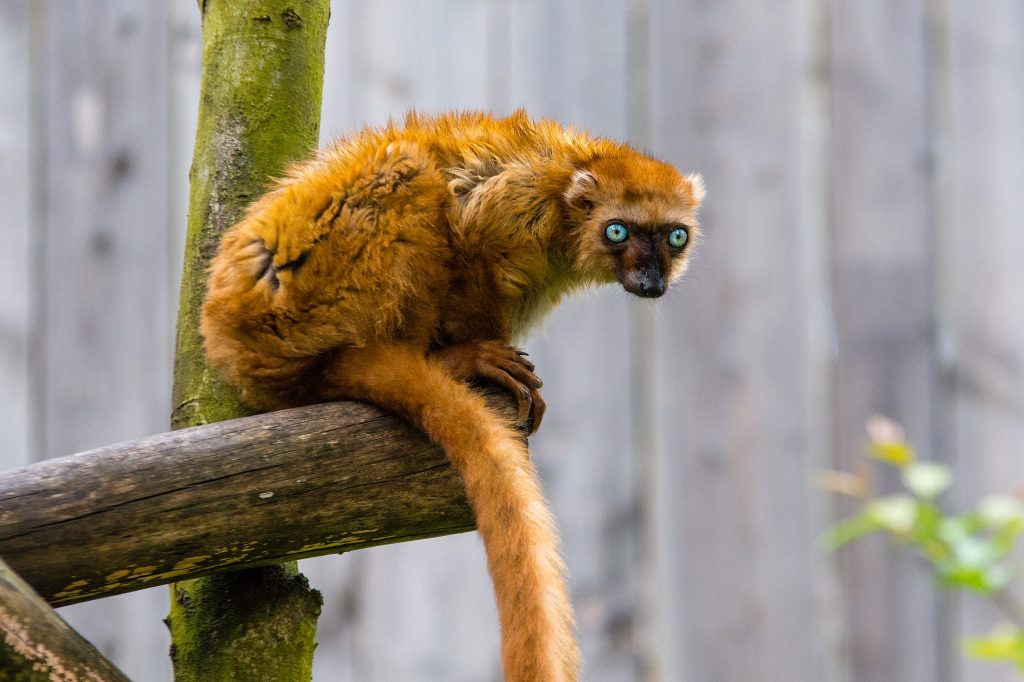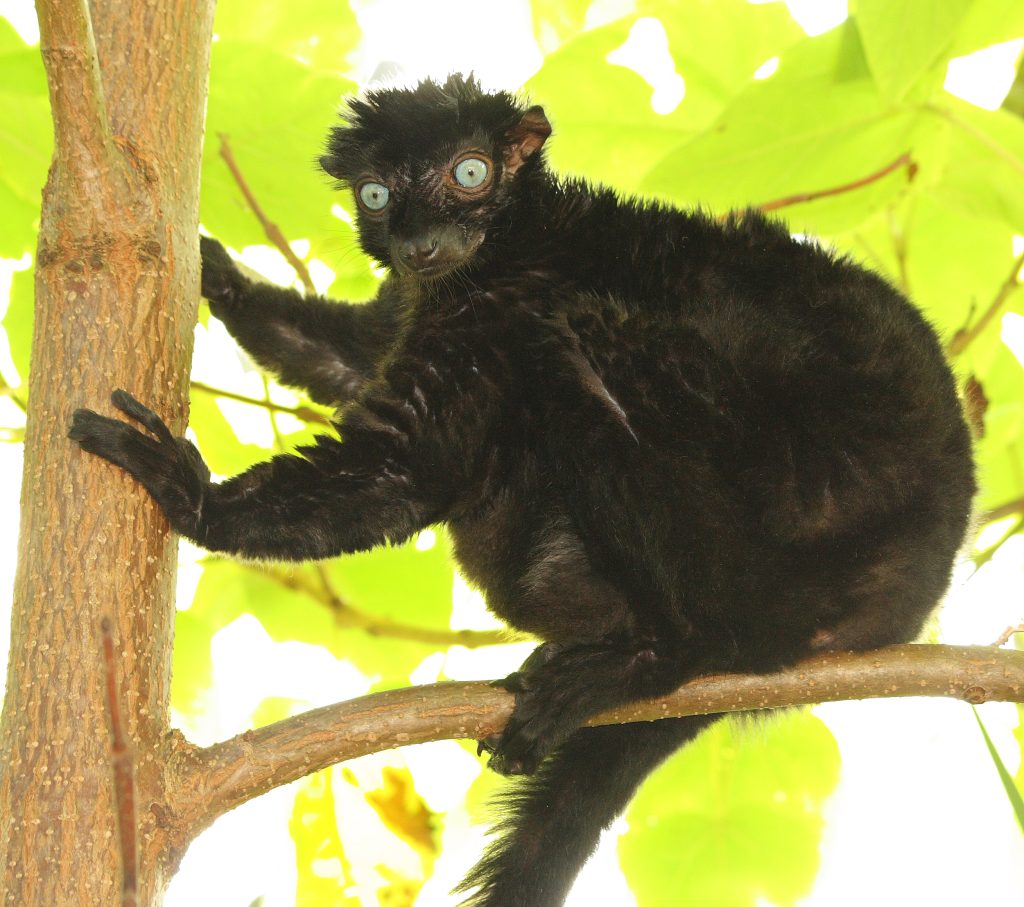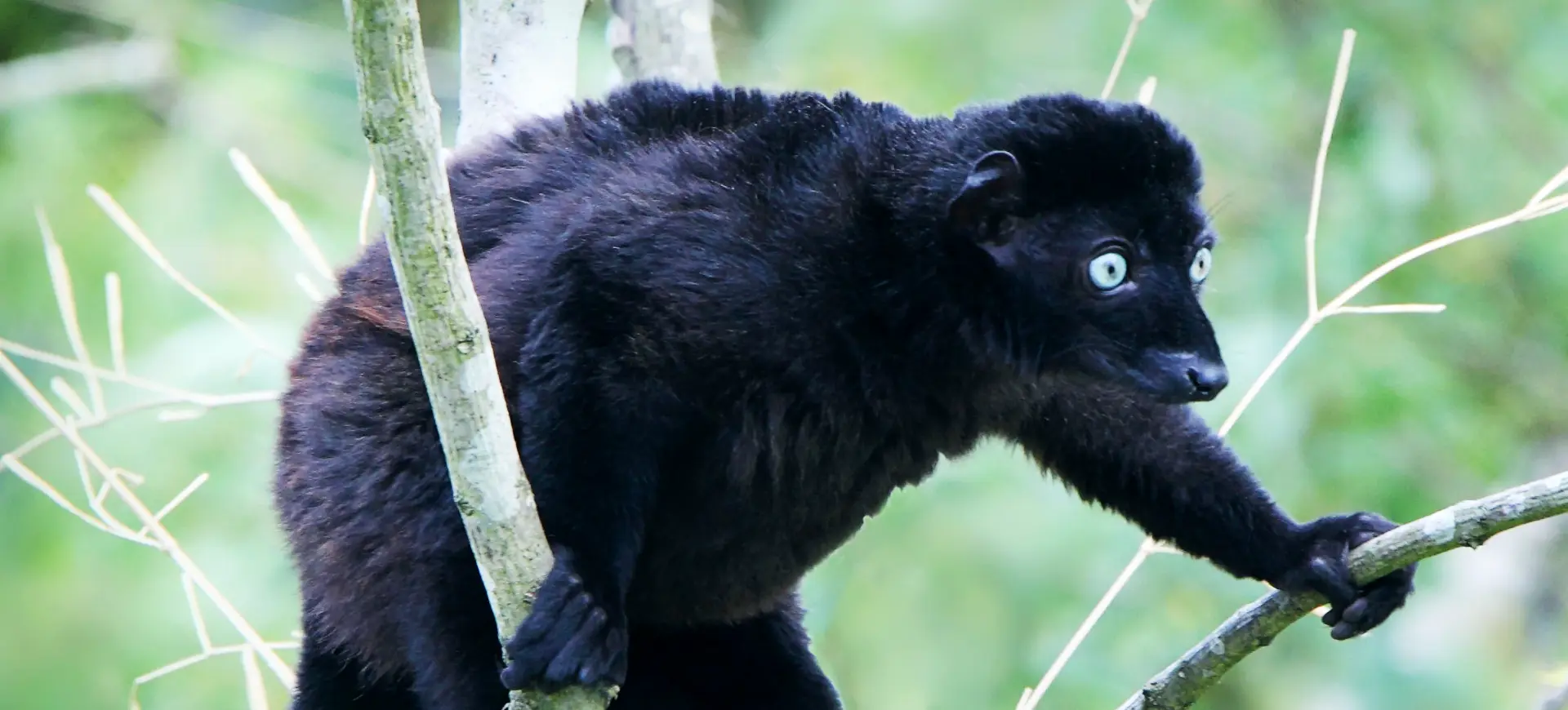Blue-Eyed Black Lemurs are dangerously close to extinction probably because they’re endemic to the Northwestern peninsula on the island of Madagascar.
It’s our duty to make sure more people learn about these friendly, lovable primates that are actually distant relatives of our own human race.
With fur as black as lacquer and incredible blue eyes, there’s much to appreciate about Black Lemurs.
Join us as we discuss 10 of the most exciting facts about the animal that are sure to pique your interest.
Blue-Eyed Black Lemurs Key Highlights
- Having been discovered as a species in 2008, Blue-eyed Black Lemurs, also known as Sclater’s Lemurs, are the only primates apart from humans to sport blue irises. They’re also sexually dichromatic, with males and females having distinctly different color coats.
- Blue-eyed Black Lemurs are incredibly territorial and cathemeral animals. Meaning they’re active throughout both the night and day, and make sure to mark the boundaries of their territory with their scent, which is also their main method of communication.
General Info About Blue-Eyed Black Lemurs
| Habitat: | Moist Forests |
| Location: | Northwestern Madagascar |
| Lifespan: | Wild: 30 years, Captivity: 30 years |
| Weight: | 4.4 to 5.9 lbs |
| Diet: | Leaves, flowers, ripe fruits, nectar, seeds, insects and small invertebrates |
| Predators: | Fossa, Madagascar Harrier-Hawk, Nile Crocodile, Henst’s Goshawk, Malagasy Ground Boa and Humans |
| Size: | Body 15.7-17.7 inches (40-45 cm), Tail 19.7-22 inches (50-56 cm) |
| Top Speed: | Unknown |
Learn more by reading our ultimate profile of the Blue-Eyed Black Lemurs profile!
Top 10 Facts About Blue-Eyed Black Lemurs
1. The Males and Females are Sexually Dichromatic

Simply put, both male and female blue-eyed Black Lemur have different physical characteristics that make them easy to distinguish from each other.
The males have black or very dark brown fur, whereas females are characterized by their reddish-brown fur. Females also have a grayish face framed with white tufts of spiky hair.
2. Despite its Name, Not all Blue-Eyed Black Lemurs Have Blue Eyes
Newsflash, not all Blue-eyed Black Lemurs have blue eyes. In reality, these creatures’ eye color can range anywhere from pale green to gray.
3. Females Run The Black Lemur Society
It is incredibly rare in mammals and especially primates for females to rule over the males. However, this is absolutely normal in Lemur society, as various scientific studies mention how females are the dominant sex in all lemur species, regardless of whatever mating system they follow.
Those who’ve studied lemur behavior in the wild note how females will often bite their mates, hit them in the head, and snatch fruit out of their hands to display their dominance. At times, a male won’t even eat his share of a meal until the females have had their fill.
4. They Were Discovered as a Species Relatively Recently
Even though the first reported sighting of the Blue-eyed Black Lemur was as far back as 1983, there had been rumblings about the animal for more than a decade up to that point. However, the animal was still properly discovered as a separate species in 2008.
The unfortunate part is that just after a decade of being properly discovered, the species was listed as endangered (more on that later).
5. Blue-Eyed Black Lemurs are Cathemeral
Blue-eyed Black Lemurs are one of the few cathemeral mammals in the animal kingdom. Cathemeral literally means “all-hours”, which in itself means that they’re active both during the day and night.
The periods where they are most active, however, occur early in the morning and late in the afternoon.
6. They Use Their Scent to Mark Their Territory
Like almost every other mammal, Black Lemurs are incredibly territorial animals. They usually mark the boundaries of their territory by spreading around their scent. Their primary scent glands are located somewhere close to their anus.
So if you ever see a Black Lemur rubbing its anogenital region against a tree or some other surface, then it’s probably marking the area with its scent. Males also have an additional scent gland located in their wrists.
7. Blue-Eyed Black Lemurs are The Only Non-Human Primates That Have Blue Eyes

Scientists have been able to document a total of 600 different primate species living on Earth, including us. Out of all of them, however, Blue-eyed Black Lemurs are the only non-human primates to sport blue irises.
That said, this unique feature could actually be impairing their vision, as scientists claim that blue eyes actually contain a very low amount of melanin, which makes them more sensitive to sunlight.
8. They’re Primarily Herbivores But Can Feast on Insects Occasionally
A Blue-eyed Black Lemur’s diet primarily consists of plants, fruits and seeds growing in and around their forest habitat. Groups of lemurs will often wait for the rainy season to eat fruit as soon as it ripens.
During the dry season, these lemurs usually sustain themselves on leaves, flowers, seeds and nectar. If they can’t find any vegetation nearby, then and only then will these vegetarians turn to eating insects.
9. Blue-Eyed Black Lemurs are Also Known as Sclater’s Lemurs
Blue-eyed Black Lemurs are also called Sclater’s Lemur in honor of Phillip Sclater, the British zoologist who discovered a myriad of Lemur species, including the Blue-eyed Black Lemur. He’s also responsible for describing and classifying many lemur species in the late 19th century.
10. They’re a Critically Endangered Species

As we’ve mentioned before, Blue-eyed Black Lemurs live in a very narrow strip of forest in the Northern Sahamalaza Peninsula in Madagascar.
This area has recently become victim to severe habitat destruction due to locals clearing out the forest to make room for agriculture fields. While this deforestation activity may ultimately benefit the locals, it has left the Blue-eyed Black Lemur population fragmented.
It is estimated that these Lemurs have lost about 80% of their population in the last 24 years. Plus, these animals are also currently being hunted for food or to keep as pets.
Taking these activities into account, the IUCN has rightfully labeled Blue-eyed Black Lemurs as a critically endangered species. Additionally, they have also started conservation efforts by transporting a few members of the species to different Zoos around the world.
Learn more by reading our ultimate profile of the Blue-Eyed Black Lemurs profile!

